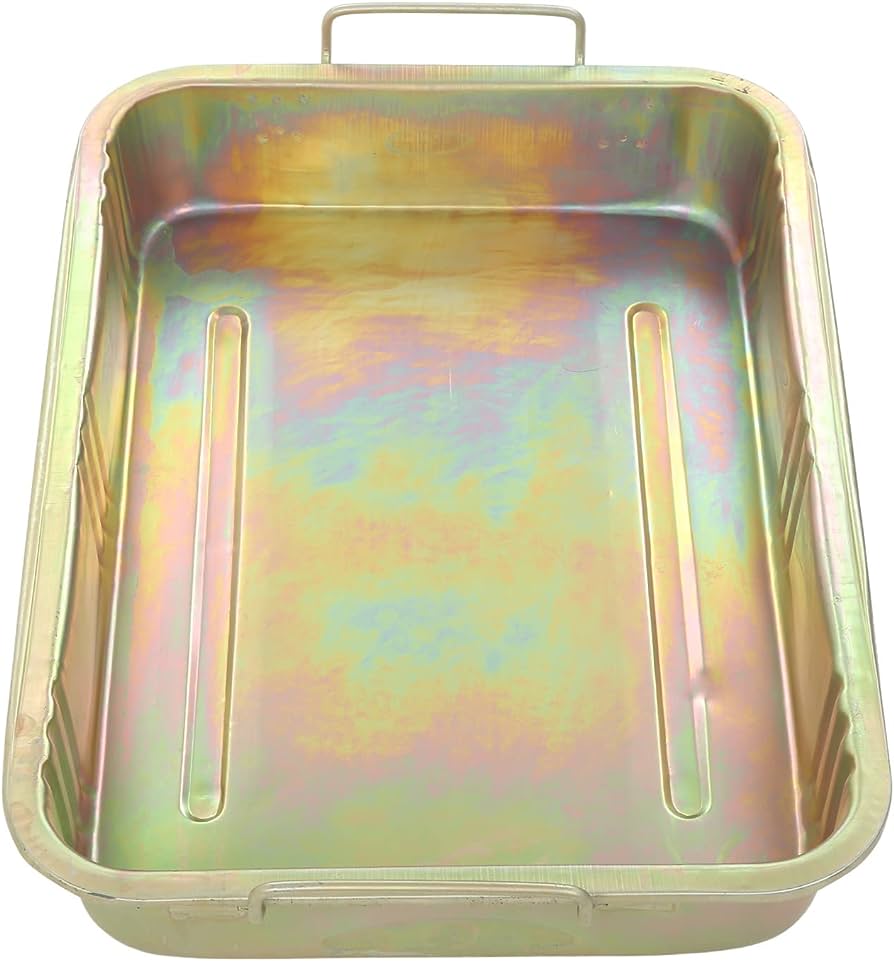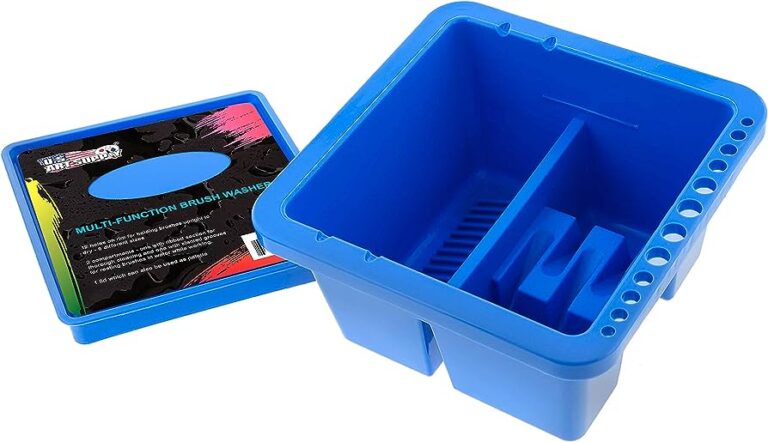Oil Drain Pan for Boats: The Essential Tool for Hassle-Free Maintenance
An oil drain pan for boats is an essential tool for hassle-free maintenance. It allows easy collection and disposal of oil during the oil change process.
A boat’s engine oil needs to be changed regularly to ensure optimal performance and prevent damage. Without a proper drain pan, the oil change process can be messy and time-consuming. A good quality oil drain pan is designed to fit under the boat’s engine and has a large capacity to hold the entire oil change.
It is easy to use, clean, and durable, making it an indispensable tool for boat owners and maintenance professionals. With an oil drain pan, boat maintenance becomes a breeze, saving time, effort, and ensuring a well-maintained engine for smooth sailing.

Credit: www.amazon.com
1. The Importance Of Regular Oil Changes For Boat Engines
Regular oil changes are crucial for maintaining the performance and longevity of boat engines. To ensure hassle-free maintenance, an oil drain pan for boats is an essential tool that facilitates the process, making it efficient and mess-free.
Why Boat Engines Require Regular Oil Changes
Boat engines, just like car engines, require regular oil changes to ensure optimal performance and longevity. Oil plays a crucial role in keeping the engine running smoothly and preventing unnecessary wear and tear. Here’s why regular oil changes are essential for boat engines:
- Lubrication: Oil acts as a lubricant, reducing friction between moving parts in the engine. This helps prevent excessive heat buildup and reduces the risk of component damage.
- Cooling: The oil also helps in dissipating heat from the engine, keeping it running at an optimal temperature. Without regular oil changes, the oil can become contaminated, losing its ability to cool the engine effectively.
- Cleaning: As the engine operates, oil collects debris, dirt, and other contaminants. Regular oil changes ensure that these impurities are flushed out, preventing them from causing damage to engine components.
- Corrosion prevention: Moisture can accumulate in the engine, leading to rust and corrosion. Fresh oil contains additives that help combat corrosion, keeping the engine protected.
- Proper sealing: Oil helps maintain the integrity of the engine’s seals. Over time, old oil can become thick and lose its ability to seal properly. Regular oil changes ensure that the seals remain in good condition, helping to prevent leaks.
The Consequences Of Neglecting Oil Changes
Neglecting oil changes for your boat engine can have serious repercussions. Here are the potential consequences of not keeping up with regular oil changes:
- Increased wear and tear: As oil ages, it breaks down and loses its effectiveness. Without regular changes, the oil becomes contaminated with debris and loses its ability to lubricate properly. This can lead to increased friction, causing excessive wear and tear on engine components.
- Reduced engine performance: As a result of increased wear, the engine’s performance may start to decline. This can lead to decreased power, rough running, and even engine stalling.
- Overheating: Contaminated oil cannot effectively cool the engine. Over time, this can lead to overheating, which can cause severe engine damage and potentially leave you stranded on the water.
- Expensive repairs: Neglecting oil changes can lead to costly repairs. Excessive wear and tear on engine components may require extensive repairs or even engine replacement, resulting in significant financial implications.
- Decreased engine lifespan: Regular oil changes help prolong the engine’s lifespan. Without proper maintenance, the engine’s components may wear out prematurely, shortening its overall lifespan.
The Role Of Oil In Engine Performance And Longevity
Oil plays a crucial role in the performance and longevity of boat engines. Here’s how oil contributes to maximizing your engine’s capabilities:
- Reduced friction: Oil lubricates the engine components, minimizing friction and reducing the risk of unnecessary wear and tear. This allows the engine to operate smoothly and efficiently.
- Heat management: Oil helps in dissipating heat from the engine, preventing overheating and maintaining optimal operating temperatures. This ensures that the engine functions at its best and avoids damage from excessive heat.
- Contaminant removal: Regular oil changes flush out impurities and contaminants that can build up over time. By keeping the oil clean, the engine is protected from harmful particles that can cause damage.
- Seal protection: Oil helps maintain the integrity of seals, preventing oil leaks and ensuring optimal engine performance. This keeps the engine protected and prevents potential damage from oil leakage.
- Engine cleanliness: Fresh oil contributes to a cleaner engine by reducing sludge buildup and removing harmful deposits. This promotes better combustion and overall engine efficiency.
By understanding the importance of regular oil changes for boat engines, you can ensure hassle-free maintenance and enjoy reliable performance on the water. Make it a priority to schedule routine oil changes to keep your boat engine running smoothly.
Gasoline Vs Diesel: Understanding The Different Oil Drain Pan Requirements
Gasoline and diesel engines have different oil drain pan requirements, especially when it comes to boats. An oil drain pan is an essential tool for hassle-free maintenance, allowing for efficient and clean oil changes to keep your boat running smoothly.
Gasoline and diesel boat engines have distinct characteristics that require specific oil drain pan requirements. Proper maintenance is essential to keep your boat’s engine running smoothly and prolong its lifespan. Understanding the unique needs of gasoline and diesel engines will help you choose the right oil drain pan for hassle-free maintenance.
Exploring The Unique Needs Of Gasoline And Diesel Boat Engines
Gasoline Engines:
- Gasoline engines are commonly used in smaller boats and are known for their high-revving performance.
- These engines require frequent oil changes due to higher combustion temperatures and potential fuel contamination.
- Oil drain pans for gasoline engines need to accommodate a larger volume of oil, typically ranging from 4 to 8 quarts.
- The pan should be made of durable materials, such as high-density polyethylene (HDPE), to withstand gasoline’s corrosive nature.
- Look for oil drain pans with built-in handles and spouts for easy and mess-free oil disposal.
Diesel Engines:
- Diesel engines are commonly found in larger boats and are known for their fuel efficiency and torque.
- These engines operate at lower RPM (revolutions per minute) and generate more heat, requiring oil drain pans with better heat dissipation.
- Oil drain pans for diesel engines should have a larger capacity to accommodate the higher oil volume needed, typically ranging from 10 to 20 quarts.
- Look for oil drain pans made of heavy-duty materials like steel or aluminum to withstand the weight and heat of diesel oil.
- A low-profile design and wide opening are desirable features, providing better access to the oil pan and making the draining process easier.
How Oil Drain Pans Differ For Each Type Of Engine
When it comes to oil drain pans, it’s crucial to consider the specific requirements of gasoline and diesel engines. Here is a breakdown of the key differences:
For gasoline engines:
- Larger volume capacity: Gasoline engines require oil drain pans that can hold a larger amount of oil, typically between 4 and 8 quarts.
- Durable materials: Given gasoline’s corrosive nature, oil drain pans made of high-density polyethylene (HDPE) are ideal for preventing leaks and damage.
- Easy oil disposal: Look for oil drain pans with built-in handles and spouts, ensuring convenient and mess-free oil disposal.
For diesel engines:
- Higher oil volume: Diesel engines generally require oil drain pans with a larger capacity, ranging from 10 to 20 quarts, to accommodate the higher oil volume needed.
- Heavy-duty materials: Oil drain pans made of steel or aluminum are preferred for their strength and ability to handle the weight and heat associated with diesel oil.
- User-friendly design: Opt for oil drain pans with a low-profile design and wide opening, making it easier to access the oil pan and facilitating a smoother draining process.
Choosing The Right Oil Drain Pan For Your Boat’S Engine
Selecting the appropriate oil drain pan is crucial for hassle-free maintenance of your boat’s engine. Consider the following factors when making your decision:
- Engine type: Identify whether your boat has a gasoline or diesel engine to determine the specific requirements.
- Oil capacity: Calculate the oil capacity of your engine, and choose an oil drain pan that can hold the necessary volume comfortably.
- Material durability: Ensure the oil drain pan is made of robust materials like high-density polyethylene (HDPE), steel, or aluminum, depending on the engine type.
- Convenient features: Look for oil drain pans with built-in handles, spouts, and a low-profile design for ease of use and mess-free oil disposal.
- Budget: Consider your budget when choosing the right oil drain pan, but prioritize quality and durability to avoid any complications during maintenance.
By understanding the unique needs of gasoline and diesel engines, as well as the corresponding oil drain pan requirements, you can make an informed decision and ensure hassle-free maintenance for your boat’s engine. Choose wisely, and enjoy a smooth and trouble-free boating experience.
2. Features To Consider When Buying An Oil Drain Pan For Boats
An oil drain pan for boats is an essential tool for hassle-free maintenance. When buying one, consider features such as size, material, and durability to ensure optimal performance and convenience. With the right oil drain pan, boat owners can easily change their engine oil and maintain their vessel with ease.
Boat maintenance is essential to keep your vessel running smoothly and ensure its longevity. One tool that is often overlooked but can greatly simplify maintenance tasks is an oil drain pan for boats. When it comes to selecting the right oil drain pan, there are a few key features to consider.
In this section, we will discuss the material options, capacity, and the importance of spout and funnel design.
Material: Comparing Plastic, Metal, And Composite Drain Pans
- Plastic drain pans:
- Lightweight and easy to handle.
- Corrosion-resistant, making them suitable for marine environments.
- Affordable option for occasional use.
- May not be as durable as metal or composite options.
- Metal drain pans:
- Sturdy and long-lasting.
- Resistant to heat and wear.
- Suitable for frequent use and heavy-duty applications.
- Can be heavy and may require extra care to prevent corrosion.
- Composite drain pans:
- Combines the advantages of plastic and metal.
- Lightweight yet durable.
- Resistant to chemicals and corrosion.
- Ideal for marine use due to their ability to withstand harsh conditions.
Capacity: Determining The Appropriate Size For Your Boat Engine
- Consider the size of your boat’s engine and the amount of oil it requires.
- Check the manufacturer’s recommendations for the capacity of the drain pan.
- Choose a drain pan with a capacity that comfortably accommodates the entire volume of oil without the risk of overflow.
Spout And Funnel Design: Why It Matters For Hassle-Free Oil Changes
- Look for a drain pan with a built-in spout:
- Allows for easy and precise pouring of used oil into a disposal container.
- Minimizes mess and reduces the risk of spills or splashes.
- Opt for a drain pan with a funnel or grooves:
- Facilitates the smooth flow of oil from the engine to the pan.
- Helps to collect all the oil without leaving any residue behind, ensuring a thorough oil change.
When selecting an oil drain pan for your boat, consider the material, capacity, spout design, and funnel design. Whether you choose a plastic, metal, or composite drain pan, ensure it is suitable for marine environments and meets your specific needs.
With the right oil drain pan, you can make boat maintenance hassle-free and enjoy smooth sailing on the waters.
Safety And Convenience Features To Look For
An oil drain pan for boats is an essential tool for hassle-free maintenance, offering safety and convenience features that every boat owner should look for. Its efficient design allows for easy oil changes, reducing the risk of spills and keeping the boat running smoothly.
Built-In Handles And Grips For Easy Maneuverability:
- The ideal oil drain pan for boats should come equipped with built-in handles and grips, making it effortless to move and position.
- These handles and grips allow for easy maneuverability, ensuring that you can quickly and securely transport the drain pan to the desired location.
- With sturdy handles and grips, you can comfortably lift and tilt the pan without worrying about it slipping or losing control.
- This feature is particularly valuable when dealing with heavy or full drain pans, as it helps prevent strain on your wrists and supports a smoother oil draining process.
Splash Guards And Drip Trays To Minimize Mess And Spills:
- Look for an oil drain pan for boats that includes splash guards and drip trays to minimize mess and spills during maintenance.
- Splash guards are designed to prevent oil from splashing or splattering outside the pan, keeping the surrounding area clean and oil-free.
- Drip trays are essential for catching any residual oil that may escape during the draining process, ensuring that it doesn’t reach the boat’s interior or contaminate the water.
- By having these features, you can maintain a clean and organized workspace, while also minimizing the risk of environmental contamination.
Anti-Slip Bottoms For Stability During Oil Drainage:
- An oil drain pan with an anti-slip bottom provides added stability during the oil drainage process, preventing accidental tipping or sliding.
- This feature is crucial when working on boats, as stability is essential to avoid spills and potential injuries.
- Anti-slip bottoms are typically made of rubber or non-skid materials, ensuring that the pan stays securely in place even when placed on uneven surfaces.
- With an oil drain pan that incorporates an anti-slip bottom, you can confidently drain the oil without worrying about any unexpected movements or accidents.
Remember to choose an oil drain pan for boats that encompasses these safety and convenience features, as they will greatly enhance your maintenance experience. With built-in handles and grips, splash guards and drip trays, and anti-slip bottoms, you can enjoy hassle-free oil changes while keeping your boat and workspace clean and safe.
3. Step-By-Step Guide To Using An Oil Drain Pan For Boats
Discover the step-by-step guide to using an oil drain pan for boats. This essential tool makes maintenance hassle-free, ensuring smooth sailing for all your boating adventures.
Preparing The Boat Engine For An Oil Change:
Before getting started with an oil change, it is important to prepare the boat’s engine to ensure a smooth and efficient process. Here’s a step-by-step guide on how to do it:
- First, make sure the boat is in a safe location, with the engine completely shut down and cool to the touch.
- Locate the oil drain plug on the engine. Consult the boat’s owner’s manual if you are unsure about its exact location.
- Gather all the necessary tools and equipment, including a wrench or socket set to remove the drain plug, a new oil filter, and the oil drain pan itself.
- Wear protective gloves and eyewear to prevent any accidental spills or injuries.
Placing The Drain Pan Correctly To Catch All The Oil:
Proper placement of the oil drain pan is crucial to prevent any messy spills and ensure that all the old oil is captured effectively. Here are the steps to follow:
- Position the boat in a way that allows easy access to the oil drain plug. Ideally, this would be on level ground to ensure accurate oil measurement and prevent any oil from pooling in one corner of the pan.
- Place the oil drain pan directly underneath the oil drain plug, ensuring that it is large enough to catch all the oil without overflowing. This will help avoid any environmental contamination and make it easier for proper disposal.
Draining The Old Oil And Properly Disposing Of It:
Now that the oil drain pan is correctly positioned, it’s time to drain the old oil from the boat’s engine. Here’s what you need to do:
- Loosen the oil drain plug using the appropriate wrench or socket set, making sure to have a steady grip on the pan as the oil starts to flow out.
- Allow all the old oil to drain completely into the oil drain pan, ensuring that it doesn’t spill over the edges.
- Once all the oil has been drained, securely tighten the oil drain plug back into place to avoid any leaks.
When it comes to proper disposal of the old oil, it is vital to adhere to environmental guidelines. Here’s what you should do:
- Transfer the used oil from the oil drain pan to a suitable container that is specifically designed for oil disposal.
- Seal the container tightly to prevent any leakage or potential harm to the environment.
- Take the container to a designated facility or check with local authorities on proper disposal methods, ensuring that you comply with all regulations.
Cleaning And Storing The Oil Drain Pan After Use:
After successfully changing the oil in your boat’s engine, it’s important to properly clean and store the oil drain pan for future use. Follow these steps:
- In a well-ventilated area, empty any remaining oil from the pan into a suitable container for disposal.
- Rinse the oil drain pan with warm soapy water, removing any oil residue.
- Thoroughly dry the pan before storing it to prevent the formation of rust or other potential damage.
- Store the clean oil drain pan in a dry and secure location, keeping it protected from any elements that could compromise its integrity.
By following this step-by-step guide and using an oil drain pan for boats, you can ensure a hassle-free maintenance experience for your boat’s engine, promoting its longevity and performance.
Tips And Tricks For A Hassle-Free Oil Change
Looking for hassle-free maintenance for your boat’s oil change? An oil drain pan is an essential tool that ensures a smooth process. Keep your boat running smoothly with these tips and tricks for a hassle-free oil change.
Changing the oil in your boat is an essential maintenance task to keep your engine running smoothly. With the right tools and techniques, you can make the process hassle-free and prevent common mistakes. In this section, we will explore some tips and tricks to ensure a seamless oil change experience.
Using Additional Tools To Make The Process Smoother
- Oil filter wrench: Use an oil filter wrench to easily remove the old oil filter. This tool provides a secure grip, ensuring a tight seal and preventing oil leakage.
- Funnel: A funnel is a handy tool for pouring new oil into the engine. It helps prevent spills and ensures accurate pouring without any mess.
- Oil drip pan: Place an oil drip pan under the oil drain plug to catch any spills or drips during the oil change process. This will help keep your workspace clean and prevent oil from contaminating the environment.
- Shop towels or rags: Keep some shop towels or rags nearby to quickly wipe away any spilled oil. This will help maintain a clean working area and prevent slipping hazards.
Preventing Common Mistakes And Avoiding Accidents
- Proper engine warm-up: Before starting the oil change process, make sure to run the engine for a few minutes to warm up the oil. Warm oil flows more easily, making it easier to drain.
- Securely position the boat: Park your boat on a level surface and engage the parking brake or use wheel chocks to prevent any accidental movement during the oil change.
- Safety precautions: Wear non-slip gloves and eye protection to protect yourself from any potential spills or splashes. If necessary, use a spill containment kit to handle any larger spills safely.
- Tightening the drain plug: After draining the oil, ensure the drain plug is properly tightened to prevent any leaks. Use a torque wrench to achieve the correct tightness recommended by the manufacturer.
Best Practices For Maintaining And Extending The Lifespan Of Your Oil Drain Pan
- Regular cleaning: After each use, thoroughly clean the oil drain pan to remove any residual oil or debris. This will prevent contamination and ensure the pan’s effectiveness for future use.
- Proper storage: Store the oil drain pan in a clean and dry location to avoid any damage or contamination. You can also consider using a lid or cover to keep it protected from dust or pests.
- Periodic inspections: Regularly inspect the oil drain pan for any signs of damage or wear. Replace it if you notice any cracks or leaks to avoid spillage during future oil changes.
- Compatibility with oil filters: Ensure your oil drain pan is compatible with the size and type of oil filters used in your boat. Choosing the right pan will make the process smoother and prevent any compatibility issues.
By following these tips and tricks, you can make your oil change process hassle-free, prevent common mistakes, and extend the lifespan of your oil drain pan. With proper maintenance and the right tools, you’ll be able to maintain a well-running engine and enjoy your boating adventures without any worries.
Frequently Asked Questions On Oil Drain Pan For Boats: The Essential Tool For Hassle-Free Maintenance
What Is The Best Oil Drain Pan?
The top-rated oil drain pan is the one that meets your needs and preferences.
How Do You Clean An Oil Drain Pan After Use?
To clean an oil drain pan after use, first dispose of the oil properly. Then, wash the pan with hot soapy water and scrub it with a brush. Finally, rinse the pan thoroughly and let it air dry.
Are Oil Drain Pans Reusable?
Yes, oil drain pans can be reused multiple times for convenience and cost-effective oil changes.
Why Use An Oil Drain Pan?
An oil drain pan is used to collect and contain oil when changing it, making it easier and cleaner.
Conclusion
Having an oil drain pan for your boat is an essential tool that can significantly simplify the maintenance process. With its ability to safely and efficiently collect used oil, it eliminates the hassle and mess associated with traditional draining methods.
By using an oil drain pan, you not only protect the environment from oil spills but also extend the life of your boat’s engine. Additionally, the convenience offered by this tool saves you valuable time and effort, allowing you to focus on enjoying your boating adventures.
Whether you are a seasoned boater or a novice, investing in an oil drain pan is a wise decision that will benefit both you and your boat in the long run. So, don’t hesitate to add this essential tool to your boating maintenance routine and experience hassle-free maintenance like never before.





